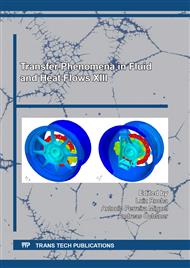[1]
B.N. Chetverushkin, Kinetic Schemes and Quasi-Gasdynamic System of Equations, CIMNE, Barcelona, (2008).
Google Scholar
[2]
T.G. Elizarova, Quasi-Gas Dynamic Equations, Springer, Berlin, (2009).
Google Scholar
[3]
M.V. Kraposhin, E.V. Smirnova, T.G. Elizarova, M.A. Istomina, Development of a new OpenFOAM solver using regularized gas dynamic equations, Computer and Fluids. 166 (2018) 163-175.
DOI: 10.1016/j.compfluid.2018.02.010
Google Scholar
[4]
T.G. Elizarova, I. A. Graur, J. C. Lengrand, Two-Fluid Computational Model for a Binary Gas Mixture, European Journal of Mechanics B. 20 (3) (2001) 351-369.
DOI: 10.1016/s0997-7546(00)01119-5
Google Scholar
[5]
T.G. Elizarova, A.A. Zlotnik, B.N. Chetverushkin, On quasi-gasdynamic and quasi-hydrodynamic equations for binary gas mixture, Dokl. Math. 90 (3) (2014) 719–723.
DOI: 10.1134/s1064562414070217
Google Scholar
[6]
T.G. Elizarova, A.A. Zlotnik, E. V. Shil'nikov, Regularized equations for numerical simulation of flows of homogeneous binary mixtures of viscous compressible gases, Comput. Math. Math. Phys. 59 (11) (2019) 1832– 1847.
DOI: 10.1134/s0965542519110058
Google Scholar
[7]
J. Quirk and S. Karni, On the dynamics of a shock-bubble interaction, J. Fluid Mech. 318, (1996) 129–163.
DOI: 10.1017/s0022112096007069
Google Scholar
[8]
R. Abgrall and S. Karni, Computations of compressible multifluids, J. Comput. Phys. 169 (2001) 594–623.
DOI: 10.1006/jcph.2000.6685
Google Scholar
[9]
E.V. Shilnikov, T.G. Elizarova, Numerical simulation of gravity instabilities in gas flows by use of the quasi gas dynamic equation system, IOP Conference Series: Materials Science and Engineering. 657 (2019) 012035.
DOI: 10.1088/1757-899x/657/1/012035
Google Scholar
[10]
T. G. Elizarova, E. V. Shil'nikov. Numerical Simulation of Gas Mixtures Based on the Quasi-Gasdynamic Approach as Applied to the Interaction of a Shock Wave with a Gas Bubble, Comput. Math. Math. Phys. 61 (1) (2021) 118-128.
DOI: 10.1134/s0965542521010048
Google Scholar
[11]
G. Chen, H. Tang, P. Zhang, Second-Order Accurate Godunov Scheme for Multicomponent Flows on Moving Triangular Meshes, J. Sci. Comp. 34 (2008) 64-86.
DOI: 10.1007/s10915-007-9162-8
Google Scholar
[12]
V.E. Borisov, Yu.G. Rykov, Simulation of multicomponent gas flows using double-flux method, Matematicheskoe modelirovanie. 32 (10) (2020) 15-29 (in Russian).
Google Scholar


